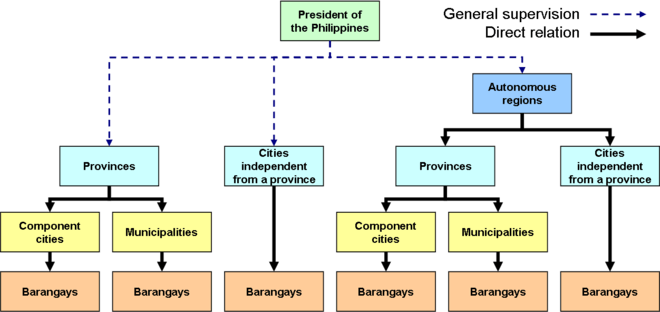Barangay Captain
A Barangay Captain (Filipino: Punong Barangay), also known as a Barangay Chairman, is the highest elected official in a barangay, the smallest level of administrative divisions of the Philippines. Sitios and puroks are sub-divisions of barangays, but their leadership is not elected. As of September 2012, there are 42,028 barangays and therefore 42,028 barangay captains.[1]
 |
|---|
| This article is part of a series on the politics and government of the Philippines |
|
|
|
Constitutional commissions |
|
Related topics |
|
|
The current position was created by the 1991 Local Government Code, and is a successor to historical positions known variously as Cabeza de Barangay, Barrio Lieutenant, and Barrio Captain.
Along with the college of Barangay Kagawad (English: Barangay Councilors), Captains comprise the Sangguniang Barangay or Barangay Council. They perform many official government duties, and execute minor judicial powers as part of Barangay Justice System, such as settling disputes between neighbours. Viewed as village elders, they also work informally with a number of organizations.
Barangay officials receive a salary of between ₱600 and ₱1,000 a month as per the Local Government Code.[2] They receive other forms of compensation as well.
Captains are elected for three-year terms. The most recent 2018 Philippine barangay and Sangguniang Kabataan elections were held on May 14, 2018.
History
While the current structure dates only to the 1970s, the concept of a village leader has a long history, as it was already evident amongst pre-colonial barangays. During the Spanish era, the office was known by the title Cabeza de Barangay (literally, "head of the barangay"), and was an unelected post.
At the beginning of the American Colonial Period, the office was renamed Barrio Lieutenant. Under the Administrative Code of 1917, passed by the Philippine Assembly, these too were not elected but rather were appointed by and under the supervision of the city councillor for the barrio.[3] Councillors were elected at that time by electoral districts. Barrio lieutenants received no pay or other compensation.[3] The lieutenant was to assist the city councillor and his term ended when the councillor's term ended.[3]
During the American Occupation and after independence in 1946, barangays were known as barrios and barangay leaders were known as Barrio Lieutenants.
In 1991, the position took its present name and form with amendments to the Local Government Code.
Relation to other governments

Here is table showing the number of provinces, municipalities, cities, and barangays in Philippines.
| Type (English) | Type (Filipino) | Head of Administration | Filipino Title | Number[4] |
|---|---|---|---|---|
| Province | Lalawigan (Probinsya) |
Governor | Gobernador | 81 |
| Municipality | Bayan (Munisipalidad) |
Mayor | Alkalde | 1,490 |
| City | Lungsod (Siyudad) |
Mayor | Alkalde | 144 |
| Barangay (Village) |
Barangay | Barangay Captain | Punong-Barangay | 42,028 |
References
- "Official Website". National Statistical Coordination Board (NSCB). Retrieved 20 April 2013.
- Golez, Prince (26 January 2014). "GSIS coverage for brgy execs mulled". Panay News. Retrieved 27 January 2014.
- "Administrative Code of 1917" or "ACT NO. 2657 AN ACT CONSISTING AN ADMINISTRATIVE CODE". The Official Gazette, managed and maintained by the Presidential Communications Development and Strategic Planning Office, Office of the President. Retrieved 12 November 2012.
- Philippine National Statistical Coordination Board (NSCB)
See also
- Ancient barangay
- Cabeza de Barangay
- League of Barangays of the Philippines
- Poblacion
- List of cities and municipalities in the Philippines
- Pecalang and Hansip
